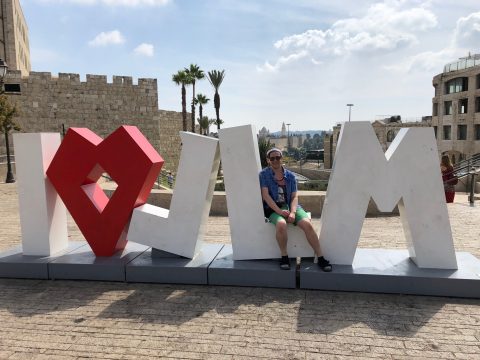 As I wrote in my last piece, this international foray is taking us to all the places I’d been in my earliest travels. Well, the next spot was more than a vacation destination: it’s the country my family lived for three years in the 1970s.
As I wrote in my last piece, this international foray is taking us to all the places I’d been in my earliest travels. Well, the next spot was more than a vacation destination: it’s the country my family lived for three years in the 1970s.
“Welcome to my third homeland!” I exclaimed to Mathew and his family as we stepped off the plane at Tel Aviv Ben-Gurion International airport. I’d already briefed them on the augmented security involved in entering the region: before departing Amsterdam, we were all interviewed individually in the check-in line, with our stories cross-checked by the plainclothes officials. It was all pretty friendly and relatively brief, though I know that’s not always the case for many.
The flight over, on Israel’s discount carrier Arkia, was straightforward enough, leaving and arriving on time with a generally well-behaved crew and passengers —something that’s not always the case in this oft-surly land. As I’ve gotten on in years and travel mileage, I’ve become of two minds about discount carriers worldwide: on the one hand, I think it’s great that they’ve opened up travel to whole swaths of the public that otherwise wouldn’t be able to get away. On the other hand, cheap fares can sometimes translate into less-than-ideal behavior from all involved.
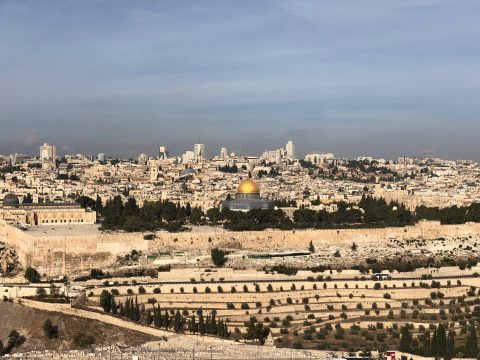 This time, though, the only hitch was luggage that took forever to show up, something that hasn’t happened to me in Israel since a visit in 1981. That hurdle cleared, we hopped in our arrival van, and rode up to Jerusalem on the newly-redone highway. Pro tip: for smaller groups or solo travelers, the newly-completed high-speed rail link from the airport to the historic city is a good choice as well.
This time, though, the only hitch was luggage that took forever to show up, something that hasn’t happened to me in Israel since a visit in 1981. That hurdle cleared, we hopped in our arrival van, and rode up to Jerusalem on the newly-redone highway. Pro tip: for smaller groups or solo travelers, the newly-completed high-speed rail link from the airport to the historic city is a good choice as well.
Following a delicious welcome meal care of my local family that evening, we took it easy the next day… which ended up working out well as it was the Jewish Sabbath. Mathew’s parents, who’ve traveled to spots all over the world, were struck by the contrast between workdays and weekend Sabbath in this country; while the holy city was pin-drop quiet on Saturday, by evening after the sun had set and the formal holiday had ended, the place came to life with restaurants, cafés and bars.
In the Footsteps of the Ancients
In keeping with that rhythm, we got an early start the next day: we’d booked a walking tour of the Old City care of Israel Maven Tours, and their name didn’t disappoint. We headed to the summit of the Mount of Olives with its picture-postcard view of the ancient metropolis.
“Most cities are located near four key must-haves,” our guide Tal explained with a relief map of the region. “Access to fresh water; a defensible, strategic location; proximity to trade routes or waterways; and easy access to arable land to grow food.”
Jerusalem, however, possesses none of these: its water source—which I’d explored in my big world trip a decade ago—is modest; it’s not located on the area’s highest ground—we in fact were looking downward at it from a neighboring mountain; and it’s in the mountains, far from fertile farmland, waterways, or major trade routes.
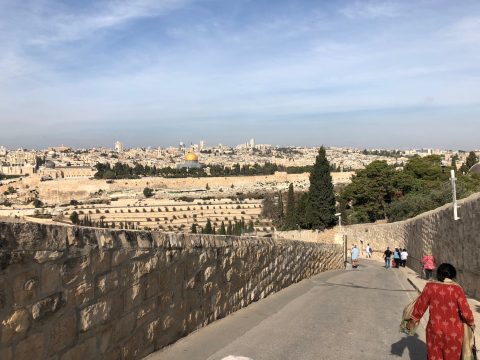 So why build a capital city here? Unsurprisingly, given the region’s tumultuous past, it was rooted in political calculus on behalf of the Israelite King David. The city was sited at a geographic confluence of all the lands of the Biblical Twelve Tribes. I couldn’t help catch the historic irony: in the Americas and Australasia, countries formed in the era of nation-states often sited their capitals similarly. To wit: Washington, D.C.; Ottawa, Canada; Brasília, Brazil; and Canberra, Australia.
So why build a capital city here? Unsurprisingly, given the region’s tumultuous past, it was rooted in political calculus on behalf of the Israelite King David. The city was sited at a geographic confluence of all the lands of the Biblical Twelve Tribes. I couldn’t help catch the historic irony: in the Americas and Australasia, countries formed in the era of nation-states often sited their capitals similarly. To wit: Washington, D.C.; Ottawa, Canada; Brasília, Brazil; and Canberra, Australia.
Guess you could call my namesake monarch a bit ahead of his time.
We strolled down the path of the Mount of Olives, past the ancient Jewish cemetery, following the route Jesus used to take to get into the city. As a rebel preacher and something of an outlaw in the city, Jesus chose to set up shop just east of the city; so call this pathway a uniquely historic commuter route.
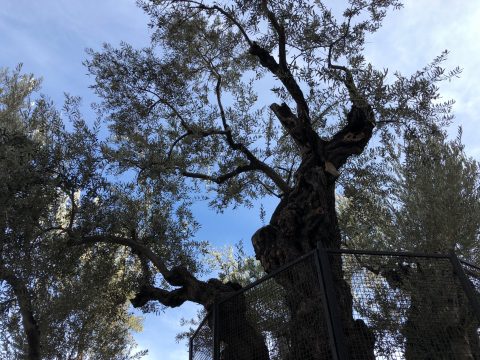 We reached the Church of All Nations that overlooks the Garden of Gethsemane. Ancient olive trees slumbered outside the majestic structure—all supervised by errant cat, who are everywhere in this land. I’d probably seen the odd olive tree in past forays here, but I’d never studied them up close: they’re monumental works of vegetation, with thick gnarled trunks and delicate leaves between which hang their edible fruit. Even the name of this place, where Jesus was arrested, is related to the trees: our guide explained that Gath Shemen in Hebrew means “olive press.”
We reached the Church of All Nations that overlooks the Garden of Gethsemane. Ancient olive trees slumbered outside the majestic structure—all supervised by errant cat, who are everywhere in this land. I’d probably seen the odd olive tree in past forays here, but I’d never studied them up close: they’re monumental works of vegetation, with thick gnarled trunks and delicate leaves between which hang their edible fruit. Even the name of this place, where Jesus was arrested, is related to the trees: our guide explained that Gath Shemen in Hebrew means “olive press.”
Inside, the relatively recently-built church (though based on predecessors going back to antiquity) presented a glorious ceiling. Dodging a few surly church ladies straight out of Dana Carvey’s comedic skits, we explored the place then continued to the Old City, entering it via the Lions Gate. A short walk brought us to the Pool of Bethesda, a spot that really accentuated the layers of history in this land: Roman cisterns commingle with Crusader and Byzantine constructions—eras as separate in time as we are now from the first European colonies in the Americas. Shallow water in the cisterns months after the most recent rainfall offered proof of Roman engineering prowess; two thousand years on and the facility still kind-of works as intended.
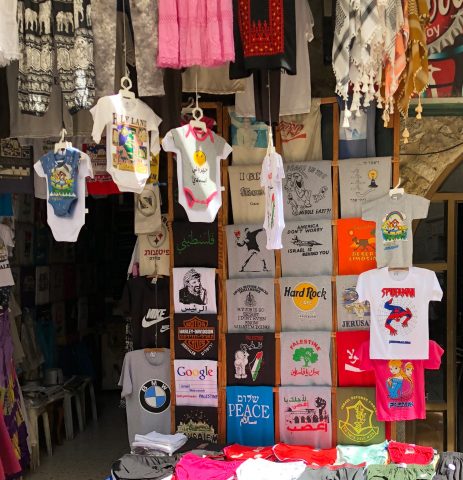 We continued down the Via Dolorosa, the “Street of Sorrows” where Jesus reputedly made his final walk. I say “reputedly” because much about the life of Christ remains hazy; of the many figures in both Old and New Testaments, many facts about the Christian progenitor remain in dispute, right down to the number of stations of the cross on this legendary road.
We continued down the Via Dolorosa, the “Street of Sorrows” where Jesus reputedly made his final walk. I say “reputedly” because much about the life of Christ remains hazy; of the many figures in both Old and New Testaments, many facts about the Christian progenitor remain in dispute, right down to the number of stations of the cross on this legendary road.
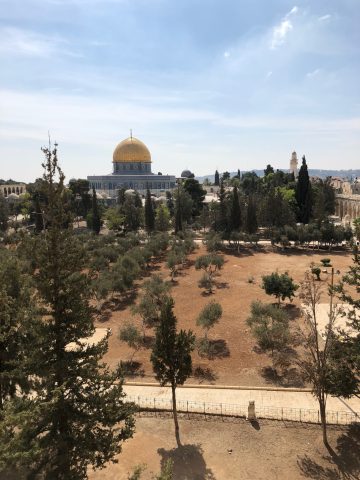 Our guide here managed to snag us an extra: a small fee to the groundskeeper of a local Islamic boys’ school afforded us a view onto the ancient Temple Mount, occupied for the last millennium-and-a-half by the Islamic Dome of the Rock shrine. Since we were deep in the Muslim Quarter of the Old City, our guide informed us that there’s no great love for the ruling power here: souvenir shops sold T-shirts with slogans that chided the Jewish state and supported a free Palestine. However, even with the vague tension we felt strolling this part of the Old City, all seemed peaceful on this Sunday morning in October.
Our guide here managed to snag us an extra: a small fee to the groundskeeper of a local Islamic boys’ school afforded us a view onto the ancient Temple Mount, occupied for the last millennium-and-a-half by the Islamic Dome of the Rock shrine. Since we were deep in the Muslim Quarter of the Old City, our guide informed us that there’s no great love for the ruling power here: souvenir shops sold T-shirts with slogans that chided the Jewish state and supported a free Palestine. However, even with the vague tension we felt strolling this part of the Old City, all seemed peaceful on this Sunday morning in October.
A few more spins through narrow streets and we arrived at the last stop on the Christian way: the Church of the Holy Sepulchre where Christ is said to have risen from what’s now an empty tomb. It’s a massive, dense structure crammed into the ancient walled city; administered by six different clerical authorities, the place is a predictable hodgepodge of styles and eras, each more wondrously atmospheric than the next.
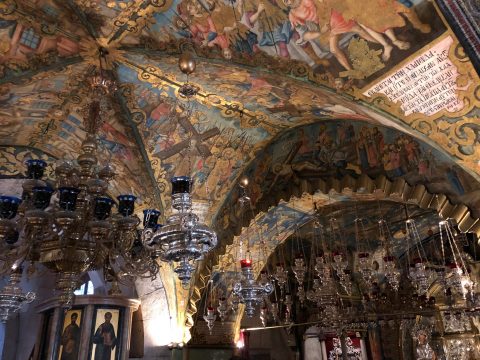 A lunch of falafel and kebabs preceded our next stops: the tomb of King David, Zion Gate, and the Jewish Quarter. In what’s probably the most unique bit of urban renewal, the Quarter, which had been leveled by the Jordanians following their capture of the Old City in 1948, was subsequently restored to its Roman-era look in the years following Israel’s conquest of the city in 1967. I’d been to the rebuilt Cardo shortly after its completion in the 1980s, but this was my first time back here since then. The theme park newness of the reconstruction contrasted with the much older bits of Old City we’d already seen.
A lunch of falafel and kebabs preceded our next stops: the tomb of King David, Zion Gate, and the Jewish Quarter. In what’s probably the most unique bit of urban renewal, the Quarter, which had been leveled by the Jordanians following their capture of the Old City in 1948, was subsequently restored to its Roman-era look in the years following Israel’s conquest of the city in 1967. I’d been to the rebuilt Cardo shortly after its completion in the 1980s, but this was my first time back here since then. The theme park newness of the reconstruction contrasted with the much older bits of Old City we’d already seen.
Spirits and Sentiments
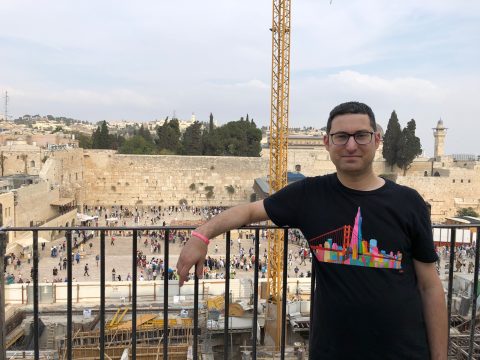 Our final stop was one I’d been to many times before, most recently on my big world trip: the Western Wall. Our guide pulled out a diagram illustrating how small a piece of the ancient Temple walls this was; while the Second Temple was built by Israelites on their return from Babylonian exile, the engineering prowess of ancient Rome, in an early attempt to pacify the Hebrews, was behind the marquee bit of showmanship here. Not content with a mere Temple sitting atop the knoll of Mount Moriah, the Romans framed the surrounding hill with a massive rectangle of walls and topped it with a pediment upon which the Temple sat. Today’s Western Wall is but a fragment of that monumental piece of ancient-world architecture.
Our final stop was one I’d been to many times before, most recently on my big world trip: the Western Wall. Our guide pulled out a diagram illustrating how small a piece of the ancient Temple walls this was; while the Second Temple was built by Israelites on their return from Babylonian exile, the engineering prowess of ancient Rome, in an early attempt to pacify the Hebrews, was behind the marquee bit of showmanship here. Not content with a mere Temple sitting atop the knoll of Mount Moriah, the Romans framed the surrounding hill with a massive rectangle of walls and topped it with a pediment upon which the Temple sat. Today’s Western Wall is but a fragment of that monumental piece of ancient-world architecture.
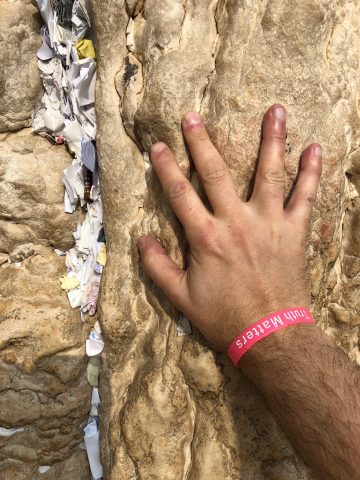 I’ve written before about my flagging devotion to religion, spirituality, and even to my own religion. Consequently, the Western Wall seemed drained of meaning to me when I was here last—particularly in the wake of conflicts with friends who professed spiritual leanings. The place, however, held much more significance to my late father, who was a passionate Jew who would visit this site on pretty much every visit he made to the city.
I’ve written before about my flagging devotion to religion, spirituality, and even to my own religion. Consequently, the Western Wall seemed drained of meaning to me when I was here last—particularly in the wake of conflicts with friends who professed spiritual leanings. The place, however, held much more significance to my late father, who was a passionate Jew who would visit this site on pretty much every visit he made to the city.
Maybe it’s because this is the first time back here since his death; maybe, because this is a year of many reminiscences contrasted against a future family we’re aiming to build. Whatever the reason, I found myself strangely moved as I came upon the great mass of the wall and placed my hand against the ancient stones. The normally clear blue sky was streaked with clouds shot through with rays of the sun. My secular, yet nonetheless emotion-laden self found the perfect melodic accompaniment to the moment: I played Beyoncé’s song “Halo” and wept more than I had in quite some time.
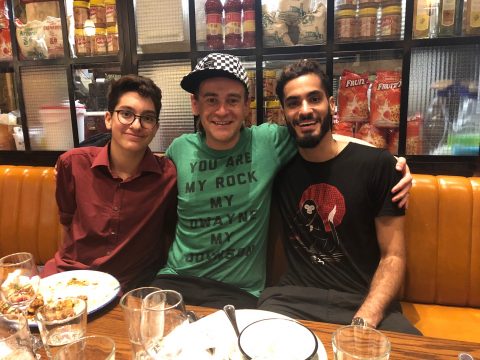 A final dinner with family at Jerusalem’s First Station—a repurposed rail depot turned trendy hangout—capped off our time in the historic city before we lit out for points beyond. One final pro tip on that point: the country’s Kosher dietary laws are something of a blessing for those with non-religious restrictions. We found a plethora of options for the vegan, vegetarian, and gluten-free crowd.
A final dinner with family at Jerusalem’s First Station—a repurposed rail depot turned trendy hangout—capped off our time in the historic city before we lit out for points beyond. One final pro tip on that point: the country’s Kosher dietary laws are something of a blessing for those with non-religious restrictions. We found a plethora of options for the vegan, vegetarian, and gluten-free crowd.
Tags: No Comments





0 responses so far ↓
There are no comments yet...Kick things off by filling out the form below.